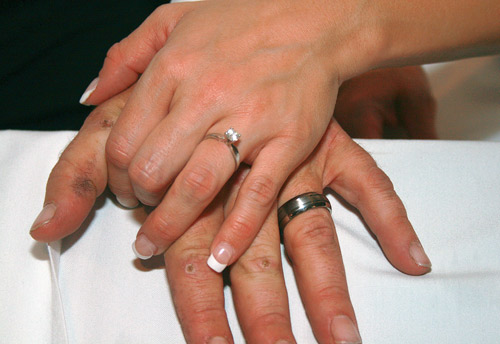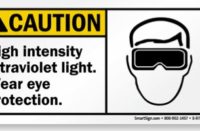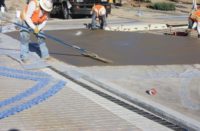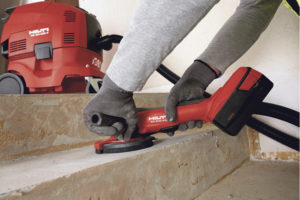
If you work with concrete you already know how abrasive, alkaline and caustic it is. To put it simply, as portland cement dries, it will absorb water from any source in order to harden. That means it will suck the moisture from your skin as well. Knowing the steps of treating and preventing concrete burns is imperative to job site safety.
It can also cause serious burns because of its alkalinity. From time to time you may have experienced a minor rash from exposure to the lime in fresh concrete. Beware thinking that is the worst that can happen. Prolonged contact can cause third-degree burns, be excruciatingly painful, keep you from working, and cause permanent scarring.
The first few minutes after contact with concrete are the most important in mitigating the effect of the burn. Once the alkaline penetrates the skin it progressively kills tissue, even if you think nothing is there. Only a slight redness may appear at first, but as time elapses, the burn will continue to worsen. These caustic burns result in skin that blisters, dies or hardens, black or green.
How can you keep yourself burn-free and healthy?
First and foremost, even if the temperature is hot on the job site, don’t take shortcuts to stay cool. OSHA (the Occupational Safety and Health Administration) recommends workers wear protective eyewear, long-sleeve shirts and long pants, coveralls, rubber boots and waterproof alkali-resistant gloves.
If any concrete gets inside your clothing, get it off and wash your skin with cool, clean water immediately. Also, if wet concrete splashes into your eyes, rinse for at least 15 minutes and then get to the hospital for further treatment without delay. If your clothing becomes saturated, change it — wet clothing will transmit alkalinity via a “hygroscopic” process, in which the fabric molecules actually become charged and will intensify the skin burn.
Immediately after flushing the skin with water, you can use common household vinegar to minimize alkaline burn injuries, a fact proved by a study published in a 2003 issue of Plastic & Reconstructive Surgery, the journal of the American Society of Plastic Surgeons. Vinegar and similar weak acids help neutralize the alkaline substance 15 minutes faster than the use of water alone, the study found. However, you should never use vinegar should the eyes. You should flush eye burns with clean water and mandate a visit to the hospital.
If a burn appears over a large skin area or is deep, professional medical attention should be obtained as quickly as possible. Remember, the skin will continue to burn unless microscopically cleaned.
It’s not just the pH
In a study funded by the National Institute for Occupational Safety and Health for the Center for Construction Research and Training (formerly known as The Center to Protect Workers’ Rights), there are various elements in concrete that can cause skin irritation or burns in addition its basic alkaline composition.
Allergic contact dermatitis (ACD) can result when skin becomes sensitized to the chromium salts in cement. These salts include hexavalent chromium or other trace metals. The onset is two to seven days after exposure, when the skin begins to sting, hurt, itch, form blisters, scabs, develop fissures, get red and become swollen. In addition to the immediate on-site treatments above, it’s important to seek medical attention for ACD because you can remain sensitized for years after this exposure. Treatment can include antibiotics for infections, astringent soaks, topical or systemic corticosteroids, antihistamines, and continual washing with pH-neutral cleaners.
Irritant contact dermatitis (ICD) can result from the combination of wetness, chemical corrosiveness and the abrasiveness of concrete. This represents 90 to 95 percent of all burn cases. Common symptoms include itching, dry flaking skin, pain, redness, swelling, small blisters, or wheals (itchy red circles with a white center). On-site treatment should include washing hands and affected areas with pH-neutral cleaners. Add vinegar to neutralize alkalinity and wash well.
Survival stories
Todd Rose, of Todd Rose Concrete Training, in Charleston, S.C., has a horror story about concrete burns that took place a week or so before his wedding. A basement pour went wrong and he was covered with wet cement from the elbows down. “I stupidly said, ‘Well it has never really bothered me, I’ll rinse off as soon as I can,’” he recalls.
That night the burns came. “I woke up at around 2 a.m. whimpering, the pain was so excruciating. And by this time vinegar did nothing.” By the time he got to the emergency room the following afternoon, he learned that there wasn’t anything that could be done for alkali burns after a certain number of hours. “I received an IV and some good pain medication,” he remembers.
A cherished keepsake photo from his wedding a few days later shows “my wife’s beautiful hand with her ring and my swollen hand with deep scabby burns,” Rose says.
“Personally, I now have vinegar on trucks on every job, use hand cream before pouring, and have started to use gloves with rubber on the bottom. Not to be a commercial, but ASCC (the American Society of Concrete Contractors) has an excellent safety program available to its members.” Rose ends with this: “I do not jackball around with alkali burns or risks anymore. Once burned ….”
Another survival story
Tim Demarest, of Rockford Stamped Concrete LLC, in Rockford, Mich., admits to getting burned often because he doesn’t like to wear gloves. “Usually when it starts, my fingertips will get little holes in them which get larger and hurt a lot. I usually soak them in lotion and then I wear Black Lightning nitrile gloves for about a week until the skin is back to normal.” He observes that “anytime you screed concrete your hands get concrete on them. However, the burns do seem worse when the humidity is down.”
Another effective home remedy comes from Mike Samford, of The Design Center, based in Nashville, Tenn. Aloe vera plants secrete a viscous sap which you can use to treat burns and is the basis of many lotions because of its innate healing properties. Samford keeps aloe vera plants at the house and at the shop. “Just break off a piece of the bulky leaf and rub it into your skin. It works for cuts, heat, sunburn and chemical burns,” he says.
Without question, prepping with the proper clothing and equipment before you and your crew work with wet concrete is by far the best antidote for concrete burns. If you do get burned, don’t ignore the contact. Take appropriate steps immediately regardless of the state of the pour.
Note: Concrete Decor magazine is not a licensed medical journal. If you or someone you love is suffering from concrete burns, please seek medical attention as soon as possible.
















